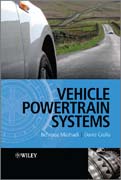
Vehicle powertrain systems: integration and optimization
Crolla, David
Mashhadi, Behrooz
The powertrain is at the heart of vehicle design; the engine whether it is a conventional, hybrid or electric design provides the motive power, which is then managed and controlled through the transmission and final drive components.The overall powertrain system therefore defines the dynamic performance and character of the vehicle. The design of the powertrain has conventionally been tackled by analyzing each of the subsystems individually and the individual components, for example, engine, transmission and driveline have received considerable attention in textbooks over the past decades. The key theme of this book is to take a systems approach to look at the integration of the components so that the whole powertrain system meets the demands of overall energy efficiency and good drivability. Vehicle Powertrain Systems provides a thorough description and analysis of all the powertrain components and then treats them together so that the overall performance of the vehicle can be understood and calculated. The text is well supported by practical problems and worked examples. Extensive use is made of the MATLAB(R) software and many example programmes for vehicle calculations are provided in the text. Key features: Structured approach to explaining the fundamentals of powertrain engineering Integration of powertrain components into overall vehicle design Emphasis on practical vehicle design issues Extensive use of practical problems and worked examples Provision of MATLAB(R) programmes for the reader to use in vehicle performance calculations This comprehensive and integrated analysis of vehicle powertrain engineering provides an invaluable resource for undergraduate and postgraduate automotive engineering students and is a useful reference for practicing engineersin the vehicle industry INDICE: Chapter 1 Vehicle powertrain concepts 1.1 Powertrain systems 3 1.2Powertrain components 11 1.3 Vehicle performance 13 1.4 Driver behaviour 18 1.5 Role of modelling 20 1.6 Aim of book 23 1.7 Further reading 24 1.8 References 24 Chapter 2 Power generation characteristics of Internal Combustion Engines 2.1 Introduction 4 2.2 Engine power generation principles 5 2.3 Engine modelling 46 2.4 Multi cylinder engines 91 2.5 Engine torque maps 107 2.6 Magic Torque (MT) formula for engine torque 117 2.7 Engine Management System 117 2.8 Net output power 117 2.9 Concluding remarks 117 2.10 Further reading 117 2.11 References 117 2.12 Review questions 117 2.13 Problems 117 Chapter 3 Vehicle Longitudinal Dynamics 3.1. Introduction 4 3.2. Torque generators 5 3.3. Tractiveforce 9 3.4. Resistive forces 26 3.5. Vehicle Constant Power Performance (CPP) 43 3.6. Constant Torque performance (CTP) 71 3.7. Fixed Throttle Performance(FTP) 82 3.8. Throttle Pedal Cycle performance (PCP) 103 3.9. Effect of rotating masses 108 3.10. Tyre slip 118 3.12. Vehicle coast down 129 3.13. Driveline losses 140 3.14. Concluding remarks 149 3.15. Further reading 149 3.16. References 150 3.17. Review questions 151 3.18. Problems 152 Chapter 4 Transmissions 4.1. Introduction 4 4.2. Need for gearbox 4 4.3. Design of gearbox ratios 7 4.4. Gearbox kinematics and tooth numbers 41 4.5. Manual transmissions 54 4.6. Automatic transmissions 127 4.7. CVTs 140 4.8. Concluding remarks 151 4.9. Further reading 152 4.10. References 153 4.11. Review questions 154 4.12. Problems 156 Chapter 5 Fuel Consumption 5.1 Introduction 4 5.2 Engine energy consumption 5 5.3 Driving cycles 11 5.4 Vehicle fuel consumption 19 5.5 Shifting effects 33 5.6 Software 46 5.7 Automated gearshifts 51 5.8 Other solutions for fuel efficiency 57 5.9 Concluding remarks 65 5.10 Further reading 66 5.11 References 68 5.12 Review questions 69 5.13 Problems 71 Chapter 6 Driveline dynamics 6.1 Introduction 3 6.2 Modelling driveline dynamics 4 6.3 Bond graph modelsof driveline components 11 6.4 Driveline models 21 6.5 Analysis 28 6.6 Concluding remarks 51 6.7 Further reading 52 6.8 References 52 6.9 Review questions 53 6.10 Problems 54 Chapter 7 Hybrid electric vehicles 7.1. Introduction 4 7.2. Types of hybrid electric vehicles 5 7.3. Power split devices 20 7.4. HEV component characteristics 49 7.5. HEV performance analysis 70 7.6. HEV component sizing 82 7.7. Power management 122 7.8. Concluding remarks 135 7.9. Further reading 136 7.10. References 137 7.11. Review questions 138 7.12. Problems 139
- ISBN: 978-0-470-66602-9
- Editorial: John Wiley & Sons
- Encuadernacion: Cartoné
- Páginas: 536
- Fecha Publicación: 13/01/2012
- Nº Volúmenes: 1
- Idioma: Inglés
